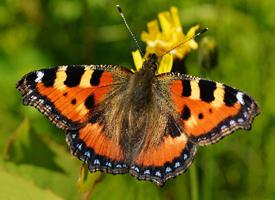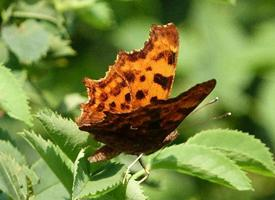
Greutăți și măsuri
| Lungimea anvergurii aripilor | de la 60 la 64 mm |
|---|
Descrierea animalului
The European peacock butterfly, scientifically known as Inachis io, is a strikingly beautiful and colorful species of butterfly that is widely recognized and admired across its range. This species belongs to the Nymphalidae family, which is known for its diverse and visually appealing members. The European peacock is distributed across the temperate regions of Europe and Asia, extending as far as Japan. It is especially prevalent in gardens, meadows, and woodlands, where its preferred habitats provide the necessary resources for its survival and reproduction.One of the most distinguishing features of the European peacock butterfly is its vibrant and ornate wings. The wingspan of an adult can reach up to 7.5 cm, making it one of the larger butterfly species found in its native habitat. The upper side of the wings showcases a deep, iridescent blue background adorned with four large, eye-catching eyespots. These eyespots are a brilliant mix of blue, black, and yellow, surrounded by a ring of iridescent purple, creating a stunning visual effect that is believed to deter predators by mimicking the eyes of larger animals.
The underside of the wings presents a stark contrast to the opulence above; it is a cryptic dark brown or maroon, providing excellent camouflage against the bark of trees and other natural surfaces when the butterfly is at rest. This ability to blend into its surroundings is a crucial survival mechanism, protecting the European peacock from potential predators.
In terms of behavior, the European peacock is a diurnal species, active during the day and resting at night. Its diet primarily consists of nectar from a variety of flowers, making it an important pollinator in its ecosystem. The larvae, or caterpillars, of the European peacock have a different diet, feeding on the leaves of nettles (Urtica dioica), which provide them with essential nutrients for growth and development.
Reproduction in the European peacock follows a typical lepidopteran pattern. Females lay eggs on the underside of nettle leaves, which hatch into caterpillars. These caterpillars then undergo several molts, growing larger with each stage, before pupating. The chrysalis stage is a time of transformation, during which the caterpillar metamorphoses into the adult butterfly. This process is a remarkable example of nature's ingenuity, resulting in the emergence of the fully formed, resplendent adult butterfly.
Conservation-wise, the European peacock is currently not considered endangered, thanks in part to its adaptability and the prevalence of its larval food plants. However, like many species, it faces threats from habitat loss, climate change, and pesticide use, which could impact its populations in the future. Conservation efforts aimed at preserving natural habitats and promoting biodiversity are crucial to ensuring the survival of this and many other species.
In summary, the European peacock butterfly (Inachis io) is a mesmerizing creature, renowned for its vivid colors and intricate patterns. It plays a vital role in its ecosystem as a pollinator and a participant in the food web. Despite its current stable status, ongoing conservation efforts are essential to safeguard its future, allowing future generations to continue to enjoy the presence of this remarkable butterfly in the wild.
Animale similare
Fotografii noi cu animale
Top 10 animale
- Dolphin gull (Leucophaeus scoresbii)
- Diana monkey (Cercopithecus diana)
- Moustached guenon (Cercopithecus cephus)
- Galápagos tortoise (Geochelone nigra complex)
- Stone loach (Barbatula barbatula)
- Greek tortoise (Testudo graeca)
- Japanese macaque (Macaca fuscata)
- Russian tortoise (Testudo horsfieldii)
- Common flying dragon (Draco volans)
- Galápagos penguin (Spheniscus mendiculus)


